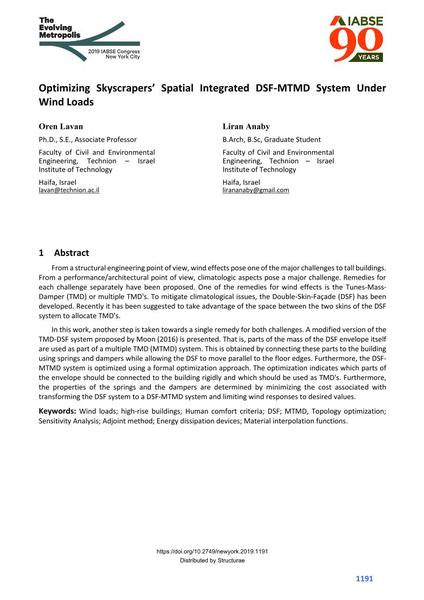Optimizing Skyscrapers' Spatial Integrated DSF-MTMD System Under Wind Loads

|
|
|||||||||||
Bibliographic Details
| Author(s): |
Oren Lavan
(Faculty of Civil and Environmental Engineering, Technion – Israel Institute of Technology)
Liran Anaby (Faculty of Civil and Environmental Engineering, Technion – Israel Institute of Technology) |
||||
|---|---|---|---|---|---|
| Medium: | conference paper | ||||
| Language(s): | English | ||||
| Conference: | IABSE Congress: The Evolving Metropolis, New York, NY, USA, 4-6 September 2019 | ||||
| Published in: | The Evolving Metropolis | ||||
|
|||||
| Page(s): | 1191-1197 | ||||
| Total no. of pages: | 7 | ||||
| DOI: | 10.2749/newyork.2019.1191 | ||||
| Abstract: |
From a structural engineering point of view, wind effects pose one of the major challenges to tall buildings. From a performance/architectural point of view, climatologic aspects pose a major challenge. Remedies for each challenge separately have been proposed. One of the remedies for wind effects is the Tunes-Mass-Damper (TMD) or multiple TMD's. To mitigate climatological issues, the Double-Skin-Façade (DSF) has been developed. Recently it has been suggested to take advantage of the space between the two skins of the DSF system to allocate TMD's. In this work, another step is taken towards a single remedy for both challenges. A modified version of the TMD-DSF system proposed by Moon (2016) is presented. That is, parts of the mass of the DSF envelope itself are used as part of a multiple TMD (MTMD) system. This is obtained by connecting these parts to the building using springs and dampers while allowing the DSF to move parallel to the floor edges. Furthermore, the DSF-MTMD system is optimized using a formal optimization approach. The optimization indicates which parts of the envelope should be connected to the building rigidly and which should be used as TMD's. Furthermore, the properties of the springs and the dampers are determined by minimizing the cost associated with transforming the DSF system to a DSF-MTMD system and limiting wind responses to desired values. |
||||
| Keywords: |
high-rise buildings sensitivity analysis wind loads topology optimization Human comfort criteria DSF MTMD adjoint method Energy dissipation devices Material interpolation functions
|
||||
